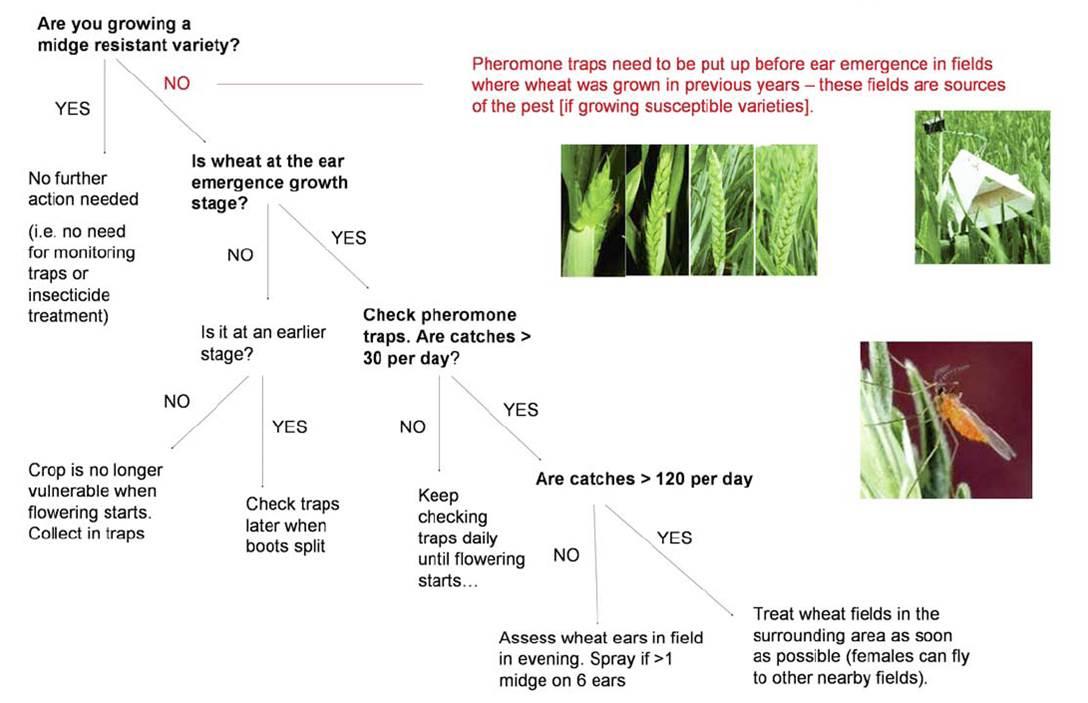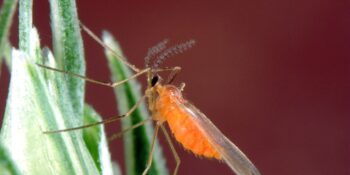Damage
The orange wheat blossom midge, Sitodiplosis mosellana, has a very patchy spatial distribution and varies from year to year depending on climatic conditions. Intensive wheat growing with successive cropping increases the risk of damage. Typically, one larva feeding on a grain site will reduce yield by about 30%. If two or three larvae feed per grain site, yield loss can be as much as 75% or even higher if ear emergence is late. In addition to direct feeding damage, larval feeding can induce premature sprouting in the ear and a reduction in Hagberg Falling Number. Secondary fungal attack by Fusarium graminearium and Septoria nodorum can follow under damp conditions.
Life Cycle
The midge overwinters in the soil as a larva in a cocoon and begins pupation only when diapause is broken (70+ days at < 10°C, sufficient rainfall to wet the soil to a depth of 10 mm, and a rise in soil temperatures to above 13°C). At this point activated larvae move towards the soil surface. The duration of the pupal stage varies according to temperature, typically spanning a period of 2 to 4 weeks. Rising temperatures following rainfall stimulate hatch of adults from pupae. Air temperatures above 15°C are particularly favourable. If conditions are unsuitable, cocoons can remain in the soil for more than 10 years. Adults mate at the emergence site and females then look for a suitable host crop. Flight usually starts 1-2 hours before dusk, especially if air temperatures are above 15°C, humidity is high and wind speed below 10km/hr. Adult midges live for about 7 days, with most eggs being laid on the third day of adult life. Eggs are laid on emerged ears, before flowering, at growth stage 53-59 of the crop (Zadoks 1974). In good conditions (i.e. good for the pest!), each female can lay around 80 eggs in batches of 2 or 3 per floret. Eggs hatch in 4-10 days, depending on temperature and the orange coloured larvae move to developing grain and feed for 2-3 weeks. Due to difficulties in detection the actual degree of damage to crops is often underestimated. Larvae may be present for 3 or 4 weeks after flowering but most leave the heads before the crop is fully ripe and after rainfall. Larvae burrow into the soil and spin protective cocoons in which they over winter.
Management Recommendations
Synthetic pheromone traps can be used to monitor male midges and provide an early warning of midge emergence in relation to the susceptible growth stages of the crop. The ovipositing female can remain well hidden in the crop canopy and the larvae are also hidden within the wheat ear, and both present a difficult spray target. Thus to achieve effective control any insecticide application has to be applied promptly before larvae burrow in-between the lemma and palea.
Resistant winter wheat varieties have near 100% resistance and many are available: The ones on the recommended list are currently ‘Skyfall’ (nabim group 1), 'LG Detroit' (nabim group 2), 'LG Prince', 'LG Illuminate', 'LG Quasar', 'LG Astronomer', 'KWS Barrel', 'KWS Firefly', 'Elicit' and ‘Merit’ (nabim group 3), 'LG Sundance', 'LG Spotlight, 'RGT Saki', 'LG Skyscraper', ‘Swallow’, 'KWS Jackal' and 'Elation' (soft group 4) and 'KWS Kerrin', ‘RGT Gravity’, ‘Gleam’, 'SY Insitor', 'KWS Cranium' and ‘KWS Kinetic’ (hard group 4).
Management decisions can be summarised as follows:

AHDB Topic Sheet - Orange wheat blossom midge – guidelines for assessment and control
The information on this page comes from Croprotect which is sponsored by the BBSRC & NERC Sustainable Agriculture Research & Innovation Club





